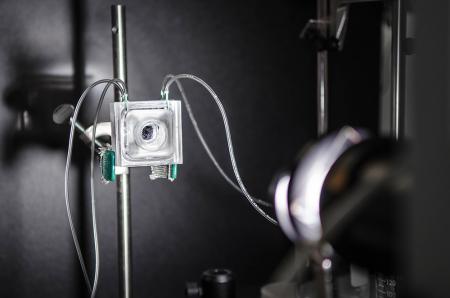![Illustration of an efficient, robust and integrated solar-driven prototype featuring protected photoelectrochemical assembly coupled with oxygen and hydrogen evolution reaction catalysts. [View full size] Credit: Image provided courtesy of Joint Center for Artificial Photosynthesis; artwork by Darius Siwek. - See more at: http://www.caltech.edu/news/artificial-leaf-harnesses-sunlight-efficient-fuel-production-47635#sthash.l86JNzpe.dpuf](https://s3-us-west-1.amazonaws.com/www-prod-storage.cloud.caltech.edu/styles/article_photo/s3/JCAP-Photoanode%20Final%20Image%201000px.jpg?itok=sDNjrzGv)
Illustration of an efficient, robust and integrated solar-driven prototype featuring protected photoelectrochemical assembly coupled with oxygen and hydrogen evolution reaction catalysts. [View full size] Credit: Image provided courtesy of Joint Center for Artificial Photosynthesis; artwork by Darius Siwek. – See more at: http://www.caltech.edu/news/artificial-leaf-harnesses-sunlight-efficient-fuel-production-47635#sthash.l86JNzpe.dpuf
Semiconductors such as silicon or gallium arsenide absorb light efficiently and are therefore used in solar panels but they oxidize (or rust) when exposed to water, so cannot be used to directly generate fuel. A major advance that allowed the integrated system to be developed was work in Lewis’s laboratory, which showed adding a 62.5nm-thick layer of titanium dioxide (TiO2) onto the electrodes could prevent them from corroding while still allowing light and electrons to pass through. The new complete solar fuel generation system improves stability of a gallium arsenide-based photoelectrode.

A highly efficient photoelectrochemical (PEC) device uses the power of the sun to split water into hydrogen and oxygen. The stand-alone prototype includes two chambers separated by a semi-permeable membrane that allows collection of both gas products. Credit: Lance Hayashida/Caltech – See more at: http://www.caltech.edu/news/artificial-leaf-harnesses-sunlight-efficient-fuel-production-47635#sthash.l86JNzpe.dpuf
Another key advance is the use of active, inexpensive catalysts for fuel production. The photoanode requires a catalyst to drive the essential water-splitting reaction. Rare, expensive platinum can serve as effective catalysts, but they could create a much cheaper, active catalyst by adding a 2-nm-thick layer of nickel to the surface of the TiO2. This catalyst is among the most active known catalysts for splitting water molecules into oxygen, protons, and electrons and is a key to the high efficiency displayed by the device.
The photoanode was grown onto a photocathode, which also contains a highly active, inexpensive, nickel-molybdenum catalyst, to create a fully integrated single material that serves as a complete solar-driven water-splitting system.
A special plastic membrane separates the gases and prevents the possibility of an explosion, while still allowing the ions to flow seamlessly to complete the electrical circuit in the cell. The demonstration system is 1cm sq, converts 10% of the energy in sunlight into stored energy in the chemical fuel, and can operate for more than 40 hrs continuously.
“This new system shatters all of the combined safety, performance, and stability records for artificial leaf technology by factors of 5 to 10 or more ,” Lewis says. http://www.caltech.edu/news/artificial-leaf-harnesses-sunlight-efficient-fuel-production-47635







Recent Comments